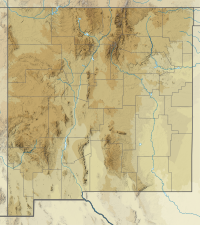| Animas Mountains | |
|---|---|
 | |
| Highest point | |
| Peak | Animas Peak |
| Elevation | 8,565 ft (2,611 m) |
| Coordinates | 31°34′10″N 108°47′19″W / 31.5695°N 108.7887°W |
| Dimensions | |
| Length | 30 mi (48 km) N-S |
| Width | 12 mi (19 km) |
| Geography | |
| Country | United States |
| State | New Mexico |
| District | Hidalgo County, NM |
| Borders on | Animas Valley-W Playas Valley-E Pyramid Mountains-N Peloncillo Mountains-W |
The Animas Mountains are a small mountain range in Hidalgo County, within the "Boot-Heel" region of far southwestern New Mexico, in the United States. They extend north–south for about 30 miles (50 km) along the Continental Divide,[1] from near the town of Animas to a few miles north of the border with Mexico. The range is about 12 miles (20 km) wide at its widest. The highest point of the range is the southern summit of the mile-long Animas Peak massif, 8,565 feet (2,611 m). (Animas Peak itself is the slightly lower north summit, 8,531 ft/2,600 m.) The Animas Mountains lie between the Animas Valley on the west and the Playas Valley on the east. Nearby ranges include the Peloncillo Mountains (Hidalgo County), across the Animas Valley, and the Big Hatchet and Little Hatchet Mountains, across the Playas Valley. [2] Physiographically, the range divides into two parts. The compact southern part, which includes Animas Peak, is higher and wider, rising up to 4,000 ft (1,200 m) above the nearby valleys. It has a sky island character, with dense coniferous forests at the higher elevations.[3] The longer, narrow northern portion is lower, reaching only 7,310 ft (2,228 m) at Gillespie Peak, and is characterized by grassland and piñon-juniper woods and shrubs.[3] The Animas Mountains lie near the Chihuahuan Desert, the Sonoran Desert, the Sierra Madre Occidental of Mexico, and the mountains surrounding the headwaters of the Gila River. Biotic influences from these regions, as well as the more distant Rocky Mountains, give the southern portion of the range a great diversity of species, including "approximately 130 species of birds, 60 species of mammals, and 40 species of reptiles."
- ^ Since both of the neighboring valleys are closed drainage basins, the designation of the Continental Divide in this region is somewhat arbitrary.
- ^ Butterfield, Mike, and Greene, Peter, Mike Butterfield's Guide to the Mountains of New Mexico, New Mexico Magazine Press, 2006, ISBN 978-0-937206-88-1
- ^ a b Animas Mountains at the New Mexico Audubon Society Archived September 29, 2007, at the Wayback Machine
